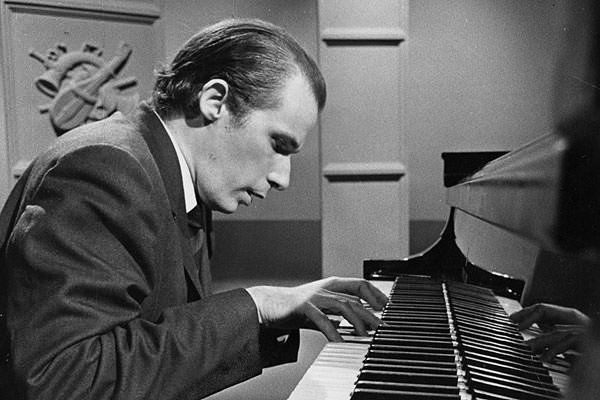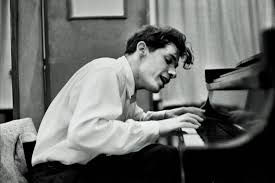GLENN GOULD
1 sayfadaki 1 sayfası
 GLENN GOULD
GLENN GOULD

Glenn Herbert Gould (25 September 1932 4 October 1982) was a Canadian pianist who became one of the best-known and most celebrated classical pianists of the 20th century.He was particularly renowned as an interpreter of the keyboard music of Johann Sebastian Bach. His playing was distinguished by remarkable technical proficiency and capacity to articulate the polyphonic texture of Bach's music.

After his adolescence, Gould rejected most of the standard Romantic piano literature including Liszt, Schumann, and Chopin. Although his recordings were dominated by Bach, Gould's repertoire was diverse, including works by Beethoven, Mozart, Haydn, Brahms, pre-Baroque composers such as Jan Pieterszoon Sweelinck, Orlando Gibbons and William Byrd, and such 20th-century composers as Paul Hindemith, Arnold Schoenberg and Richard Strauss. Gould was well known for various eccentricities, from his unorthodox musical interpretations and mannerisms at the keyboard to aspects of his lifestyle and personal behaviour. He stopped giving concerts at the age of 31 to concentrate on studio recording and other projects. Gould was the first pianist to record any of Liszt's piano transcriptions of Beethoven's symphonies (beginning with the Fifth Symphony, in 1967).
Gould was also known as a writer, composer, conductor, and broadcaster. He was a prolific contributor to musical journals, in which he discussed music theory and outlined his musical philosophy. His career as a composer was less distinguished. His output was minimal and many projects were left unfinished. There is evidence that, had he lived beyond 50, he intended to abandon the piano and devote the remainder of his career to conducting and other projects. As a broadcaster, Gould was prolific. His output ranged from television and radio broadcasts of studio performances to musique concrète radio documentaries about life in the Canadian wilderness.
Glenn Herbert Gould was born at home in Toronto on September 25, 1932, to Russell Herbert ("Bert") Gold and Florence ("Flora") Emma Gold (née Greig), Presbyterians of Scottish and English ancestry. His maternal grandfather was a cousin of Norwegian composer Edvard Grieg (who was himself of Scottish ancestry). The family's surname was changed to Gould informally around 1939 in order to avoid being mistaken for Jewish, given the prevailing anti-Semitism of prewar Toronto and the Gold surname's Jewish association.[ Gould had no Jewish ancestry,though he sometimes made jokes on the subject, like "When people ask me if I'm Jewish, I always tell them that I was Jewish during the war." Gould grew up in a home at 32 Southwood Drive, Toronto. His childhood home has been named a historic site by the City of Toronto.

Gould in February 1946 with his parakeet, Mozart, and his English Setter, Nick(y).
Gould's interest in music and his talent as a pianist became evident very early. Both his parents were musical, and his mother, especially, encouraged the infant Gould's early musical development. Before his birth, his mother planned for him to become a successful musician, and thus exposed him to music during her pregnancy. As a baby, he reportedly hummed instead of crying and wiggled his fingers as if playing chords, leading his doctor to predict that he would "be either a physician or a pianist". By the age of three, Gould's perfect pitch was noticed. He learned to read music before he could read words. When presented with a piano, the young Gould was reported to strike single notes and listen to their long decay, a practice his father Bert noted was different from typical children. Gould's interest in the piano proceeded side by side with an interest in composition. He would play his own little pieces for family, friends, and sometimes large gatherings, including, in 1938, a performance at the Emmanuel Presbyterian Church (a few blocks from the Gould house) of one of his own compositions.[14] At the age of six, he was taken for the first time to hear a live musical performance by a celebrated soloist. This left a tremendous impression. He later described the experience:
It was Hofmann. It was, I think, his last performance in Toronto, and it was a staggering impression. The only thing I can really remember is that, when I was being brought home in a car, I was in that wonderful state of half-awakeness in which you hear all sorts of incredible sounds going through your mind. They were all orchestral sounds, but I was playing them all, and suddenly I was Hofmann. I was enchanted.
Glenn Gould with his teacher, Alberto Guerrero, demonstrating Guerrero's technical idea that Gould should pull down at keys instead of striking them from above. The photo was taken in 1945, before Gould fully developed this technique.
As a young child, Gould was taught piano by his mother. At the age of 10, he began attending The Royal Conservatory of Music in Toronto. He studied music theory with Leo Smith, the organ with Frederick C. Silvester, and piano with Alberto Guerrero. Around the same time, he injured his back as a result of a fall from a boat ramp on the shore of Lake Simcoe.This incident is almost certainly related to the adjustable-height chair his father made shortly thereafter. Gould's mother would urge the young Gould to sit up straight at the keyboard.He used this chair for the rest of his life and took it with him almost everywhere. The famous chair was designed so that Gould could sit very low at the keyboard. The chair allowed him to pull down on the keys rather than striking them from above, a central technical idea of his teacher at the Conservatory, Alberto Guerrero.
Gould developed a technique that enabled him to choose a very fast tempo while retaining the separateness and clarity of each note. His extremely low position at the instrument arguably permitted more control over the keyboard. Gould showed considerable technical skill in performing and recording a wide repertoire including virtuosic and romantic works, such as his own arrangement of Ravel's La valse and Liszt's transcriptions of Beethoven's fifth and sixth symphonies. Gould worked from a young age with his teacher Alberto Guerrero on a technique known as finger-tapping: a method of training the fingers to act more independently from the arm.

Gould passed his final Conservatory examination in piano at the age of 12 (achieving the "highest marks of any candidate"), thus attaining "professional standing as a pianist" at that age. One year later he passed the written theory exams, qualifying for an ATCM diploma
1 sayfadaki 1 sayfası
Bu forumun müsaadesi var:
Bu forumdaki mesajlara cevap veremezsiniz